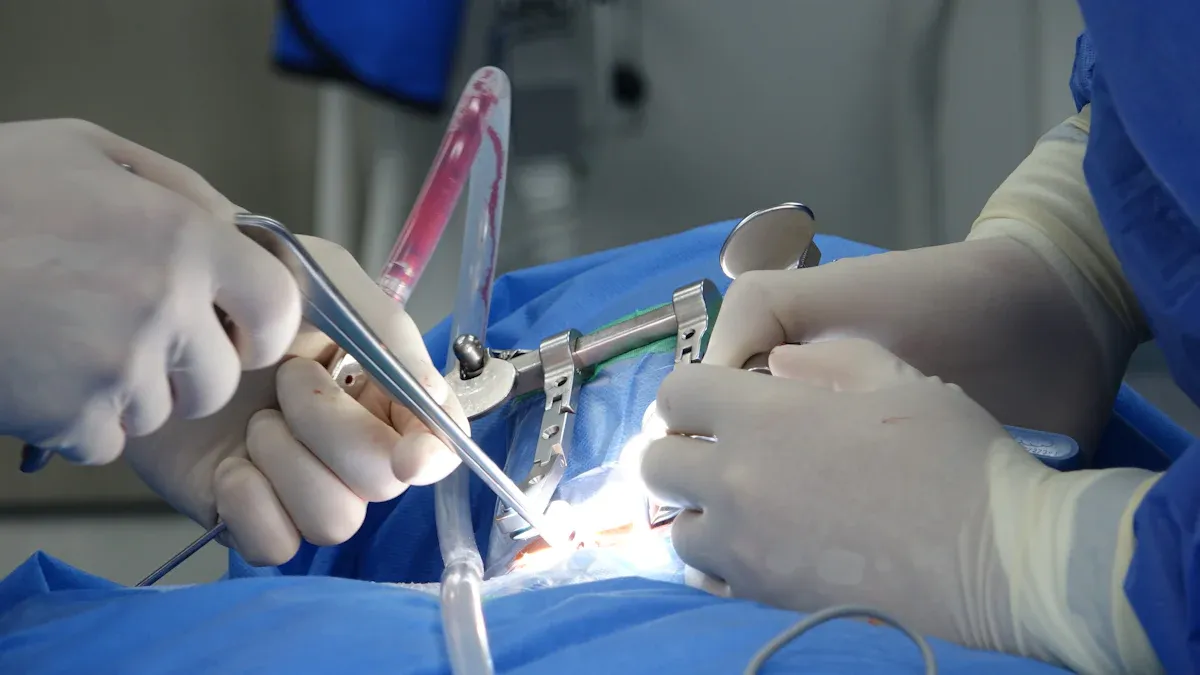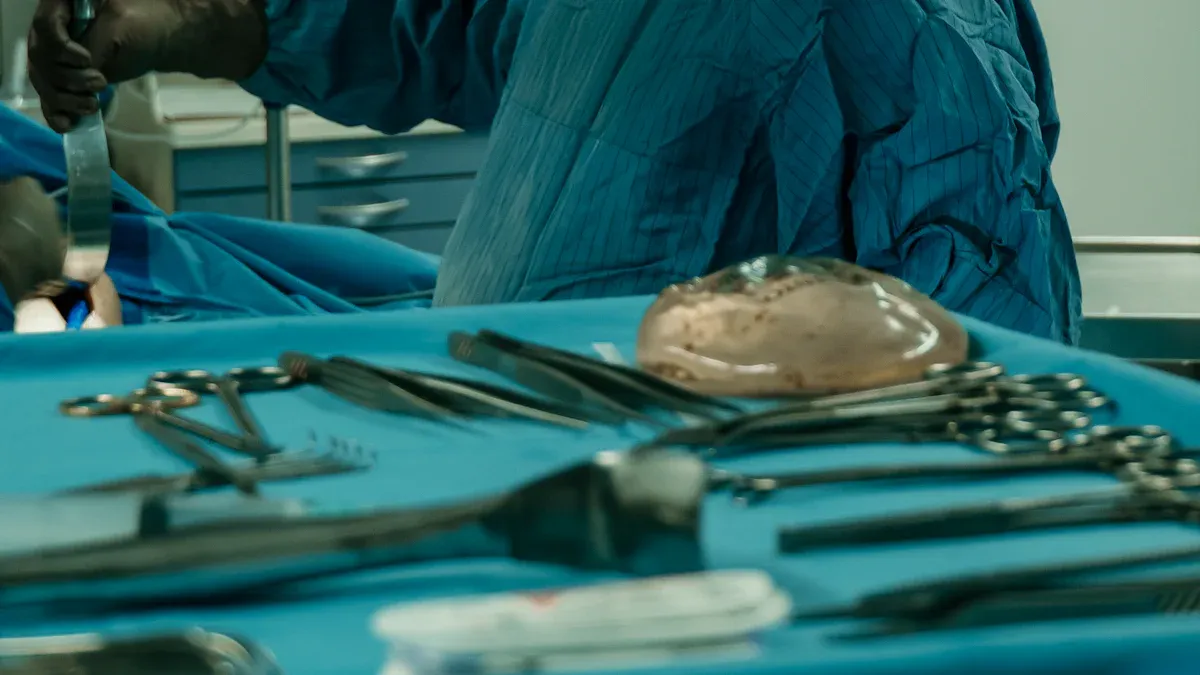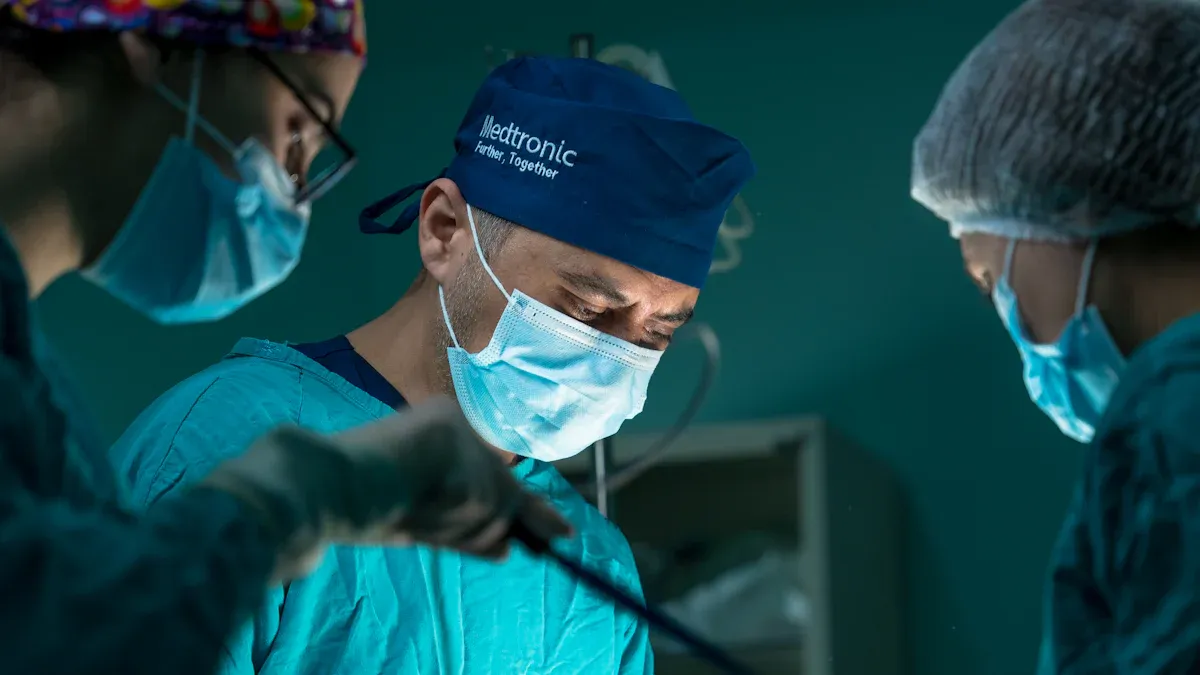Customizable Nitinol Guidewires for Neurosurgery What You Need to Know in 2025

Customizable Nitinol Guidewire for Neurosurgery has transformed the field of neurology by delivering unparalleled adaptability and precision. Crafted from a nickel-titanium alloy, these innovative tools exhibit remarkable properties such as shape memory and superelasticity, enabling them to navigate the intricate pathways of the human brain with exceptional ease.
The importance of the Customizable Nitinol Guidewire for Neurosurgery lies in its ability to enhance both precision and safety during procedures. Neurosurgeons depend on these guidewires to minimize risks in delicate operations. By reducing trauma to surrounding tissues, they contribute to improved patient outcomes and faster recovery times. This groundbreaking advancement marks a significant step forward in ensuring safety and success in complex neurosurgical interventions.
Key Takeaways
Custom nitinol guidewires help surgeons work safely in the brain.
Nitinol's special traits, like bending back to shape and flexibility, protect tissues and improve patient health.
Using nitinol guidewires means smaller cuts, faster healing, and less pain.
New nitinol improvements will make them stronger and easier to customize.
Doctors and makers must work together to solve nitinol challenges.
Unique Properties of Nitinol Guidewire Technology

Shape Memory and Its Importance
Nitinol guidewire technology leverages the unique property of shape memory, which allows the material to return to its original shape after deformation. This characteristic is particularly valuable in neurosurgery, where precision is critical. When navigating intricate brain structures, the guidewire can adapt to the complex pathways and revert to its intended form, ensuring consistent performance.
Shape memory also enhances the reliability of nitinol guidewires during procedures. Surgeons can manipulate the wire without worrying about permanent deformation, which reduces the risk of complications. This adaptability makes nitinol guidewire technology indispensable for procedures requiring high levels of accuracy and control.
Tip: Shape memory ensures that nitinol guidewires maintain their integrity even under challenging conditions, making them a safer choice for delicate neurosurgical interventions.
Superelasticity for Complex Pathways
Superelasticity for exceptional control is another defining feature of nitinol guidewire technology. This property allows the guidewire to bend and flex significantly without breaking or losing its shape. In neurosurgery, where pathways are often tortuous and unpredictable, superelasticity provides surgeons with the flexibility needed to navigate safely and effectively.
The comparative performance metrics of superelasticity highlight its advantages over traditional materials:
Metric | Nitinol Guidewire Technology | Traditional Materials |
|---|---|---|
Flexibility | High | Low |
Durability | High | Moderate |
Shape Memory | Yes | No |
Kink Resistance | High | Low |
Biocompatibility | Excellent | Varies |
Maneuverability | Enhanced | Limited |
This table underscores the superiority of nitinol guidewires in terms of flexibility, durability, and maneuverability. These attributes ensure that surgeons can perform complex procedures with greater confidence and precision.
Biocompatibility for Patient Safety
The biocompatibility of nitinol guidewire technology plays a crucial role in ensuring patient safety. Nitinol's composition minimizes the risk of adverse reactions when in contact with bodily tissues. The FDA has emphasized the importance of evaluating the biocompatibility of nitinol devices, including assessments for potential allergic reactions to nickel, a component of nitinol.
Several factors contribute to the safety of nitinol guidewires:
Nitinol's corrosion resistance ensures long-term reliability.
Its durability allows the guidewire to withstand repeated use without compromising performance.
The material's ability to flex and bend reduces trauma to surrounding tissues during procedures.
Manufacturers conduct rigorous testing to evaluate susceptibility to corrosion.
Biocompatibility assessments ensure minimal risk of allergic reactions.
Performance evaluations under stress and temperature conditions confirm the material's reliability.
These measures guarantee that nitinol guidewires meet the highest standards of safety, making them a trusted choice for neurosurgical applications.
Applications of Customizable Nitinol Guidewire for Neurosurgery

Use in Minimally Invasive Procedures
Customizable nitinol guidewire for neurosurgery has become a cornerstone in minimally invasive surgical procedures. These guidewires enable surgeons to perform complex operations with reduced trauma to surrounding tissues. Their flexibility and precision allow for smaller incisions, which significantly lower the risk of complications. Patients benefit from shorter recovery times and less postoperative discomfort, making minimally invasive techniques a preferred choice in modern neurosurgery.
The adaptability of nitinol guidewire technology is particularly advantageous in these procedures. Its shape memory and superelasticity ensure smooth navigation through intricate pathways, even in challenging anatomical regions. This capability minimizes the need for repeated adjustments, enhancing the efficiency of the operation.
AccuPath, a leading manufacturer of nitinol tubing, plays a pivotal role in advancing these medical applications. Their high-quality nitinol materials ensure that guidewires meet the rigorous demands of neurosurgical procedures. By providing reliable and customizable solutions, AccuPath supports the growing adoption of minimally invasive techniques in neurosurgery.
Role in Aneurysm Treatment
Aneurysm treatment represents one of the most critical medical applications of nitinol guidewire technology. These guidewires are instrumental in delivering coils or stents to the affected area with unparalleled precision. Their ability to navigate the complex vascular structures of the brain ensures that the treatment targets the aneurysm without damaging surrounding tissues.
The superelasticity of nitinol guidewires allows them to adapt to the tortuous pathways of cerebral arteries. This flexibility reduces the risk of complications during the procedure, such as vessel perforation or misplacement of the device. Additionally, the biocompatibility of nitinol ensures that the guidewire remains safe for use within the delicate environment of the brain.
AccuPath's expertise in producing durable and customizable nitinol tubing has made them a trusted partner for medical device manufacturers. Their commitment to quality ensures that nitinol guidewires used in aneurysm treatment meet the highest standards of safety and performance.
Precision in Navigating Brain Structures
The precision offered by customizable nitinol guidewire for neurosurgery is unmatched. These guidewires excel in navigating the intricate and delicate structures of the brain, where even the slightest error can have significant consequences. Their shape memory property allows them to maintain their intended form, ensuring consistent performance throughout the procedure.
Surgeons rely on nitinol guidewires for accurate navigation in procedures such as tumor resections, vascular repairs, and deep brain stimulation. The guidewire's ability to bend and flex without losing its shape provides the control needed to reach targeted areas safely. This precision reduces the risk of collateral damage, improving patient outcomes and recovery times.
AccuPath's advanced nitinol tubing solutions contribute to the success of these medical applications. Their customizable designs cater to the specific needs of neurosurgeons, enabling them to perform highly specialized procedures with confidence. By prioritizing innovation and quality, AccuPath continues to support the evolving demands of neurosurgical practices.
Benefits of Nitinol Guidewire Technology
Enhanced Precision in Neurosurgery
Nitinol guidewire technology offers unmatched precision in neurosurgery. Its shape memory and superelasticity allow surgeons to perform procedures with enhanced navigation through complex brain structures. These properties ensure that the guidewire maintains its intended form, even in challenging pathways. This reliability reduces the risk of errors during operations, improving safety and outcomes.
Comparative studies highlight the advantages of nitinol guidewires over conventional tools. The following table illustrates key differences:
Feature | Nitinol Guidewires | Conventional Tools |
|---|---|---|
Flexibility | High | Moderate |
Kink Resistance | Excellent | Low |
Complication Rate Reduction | 25% lower than stainless steel | N/A |
Maneuverability | Superior | Limited |
These benefits make nitinol guidewire technology indispensable for neurosurgical procedures requiring precise navigation and control. AccuPath’s customizable nitinol tubing ensures that surgeons have access to high-quality materials tailored to their specific needs, further enhancing precision in neurology.
Improved Patient Outcomes and Recovery
Nitinol guidewire technology significantly improves patient outcomes and recovery rates. Its flexibility and adaptability enable minimally invasive procedures, which result in smaller incisions and reduced trauma to surrounding tissues. Patients experience quicker healing and less postoperative pain, contributing to improved comfort and satisfaction.
Studies show that nitinol devices improve recovery rates by 20% compared to traditional materials. Their biocompatibility minimizes the risk of inflammation or rejection, ensuring that medical devices work harmoniously with the body. The following table summarizes these benefits:
Metric | Nitinol Devices | Traditional Materials |
|---|---|---|
Recovery Improvement | 20% | N/A |
Pain Level Reduction | Quicker recovery | N/A |
Risk of Complications | Lower | N/A |
AccuPath’s advanced nitinol tubing solutions contribute to these improved patient outcomes. Their commitment to quality ensures that nitinol guidewires meet the highest standards of safety and performance, supporting faster recovery and reduced risk of complications.
Versatility Across Neurosurgical Applications
The versatility of nitinol guidewire technology makes it suitable for a wide range of neurosurgical applications. Its enhanced navigation capabilities allow surgeons to perform procedures such as aneurysm treatment, tumor resections, and vascular repairs with greater confidence. The guidewire’s ability to flex and adapt ensures safe and effective navigation through delicate brain structures.
AccuPath’s customizable nitinol tubing plays a vital role in supporting this versatility. Their innovative designs cater to the specific requirements of neurosurgeons, enabling them to address diverse challenges in neurology. By prioritizing adaptability and reliability, AccuPath continues to drive advancements in nitinol guidewire technology, ensuring its widespread application across neurosurgical practices.
Challenges in Customizable Nitinol Guidewire Adoption
High Costs and Manufacturing Complexities
The adoption of nitinol guidewire technology faces significant financial and production hurdles. Recent market analysis highlights the impact of U.S. tariffs introduced in 2025, which have increased the cost of nitinol materials. Manufacturers now contend with higher import duties, forcing them to recalibrate procurement strategies. Design variations, such as dual-coated or radiopaque-enhanced guidewires, further inflate production expenses.
Technical complexities in manufacturing nitinol devices also pose challenges. The material requires precise handling to maintain its unique properties, such as shape memory and superelasticity. Regulatory compliance adds another layer of difficulty, as manufacturers must meet stringent quality assurance standards. These factors collectively hinder market growth and limit the widespread adoption of customizable nitinol guidewires.
Training Requirements for Medical Professionals
Medical professionals must undergo specialized training to use nitinol guidewires effectively. These devices demand a deep understanding of their unique properties, including shape memory and superelasticity. Surgeons must learn how to manipulate the guidewire during procedures without compromising its integrity.
Training programs often require significant time and resources, which can deter hospitals and clinics from adopting the technology. Institutions must invest in simulation-based learning environments to ensure surgeons gain hands-on experience. The complexity of neurosurgical procedures amplifies the need for comprehensive training, as even minor errors can lead to serious complications.
Integration into Clinical Practice
Integrating nitinol guidewire technology into clinical practice presents logistical challenges. Hospitals must adapt their existing workflows to accommodate the specialized requirements of these devices. Procurement teams face difficulties in sourcing high-quality nitinol guidewires due to fluctuating costs and limited availability.
Clinical staff must also adjust to the new technology, which may involve revising procedural protocols. For example, minimally invasive procedures using nitinol guidewires require different preparation and execution methods compared to traditional techniques. These adjustments can slow the adoption process, particularly in smaller healthcare facilities with limited resources.
Despite these challenges, the benefits of nitinol guidewire technology—such as improved precision and patient outcomes—continue to drive interest among neurosurgical teams. Manufacturers and healthcare institutions must collaborate to address these barriers and ensure the successful integration of this innovative technology.
Future Trends in Nitinol Guidewire Technology
Advancements in Customization Techniques
Customization in nitinol guidewire technology is advancing rapidly. Manufacturers are now leveraging 3D printing and laser machining to create guidewires tailored to specific neurosurgical needs. These techniques allow for precise adjustments in diameter, flexibility, and coating, ensuring compatibility with diverse procedures. For example, surgeons can now select guidewires with enhanced radiopacity for better visualization during imaging-guided operations.
Another breakthrough involves the integration of smart materials into nitinol guidewires. These materials enable real-time feedback on pressure and positioning, helping surgeons navigate complex pathways with greater accuracy. This level of customization reduces the risk of errors and enhances the overall success rate of neurosurgical procedures.
Innovations in Material Durability
Recent studies highlight significant improvements in the durability of nitinol guidewires. These advancements ensure that the guidewires maintain their functionality even under extreme conditions. The following table summarizes key properties contributing to their longevity:
Property | Description |
|---|---|
High Tensile Strength | Nitinol's ability to withstand significant stress without breaking, crucial for guidewire longevity. |
Fatigue Resistance | Nitinol can endure repeated mechanical stress, ensuring functionality over time. |
Corrosion Resistance | The stable oxide layer prevents degradation, enhancing longevity in bodily environments. |
Flexibility | Nitinol's flexibility allows it to navigate complex pathways, improving usability and durability. |
These innovations make nitinol guidewire technology more reliable for repeated use in neurosurgical procedures. Enhanced durability also reduces the need for frequent replacements, lowering costs for healthcare providers.
Emerging Neurosurgical Applications
The versatility of nitinol guidewire technology is paving the way for new applications in neurology. One promising area is the treatment of neurovascular malformations, where guidewires deliver embolic agents with unparalleled precision. Additionally, researchers are exploring their use in robotic-assisted surgeries, where nitinol's flexibility and shape memory enhance the precision of robotic arms.
Another emerging application involves the integration of nitinol guidewires with advanced imaging technologies. This combination allows surgeons to visualize real-time movements of the guidewire, improving accuracy in procedures like deep brain stimulation. These developments highlight the expanding role of nitinol guidewire technology in addressing complex neurosurgical challenges.
Customizable Nitinol guidewires have become indispensable tools in neurosurgery. Their unique properties, including flexibility, durability, and compatibility with imaging techniques, enhance precision and safety during complex procedures. These advancements have transformed how surgeons navigate intricate anatomical structures, improving the effectiveness of medical interventions.
Nitinol guidewires support minimally invasive surgeries, reducing trauma and elevating patient care standards.
Continuous innovations in manufacturing promise even greater reliability and adaptability for future applications.
Ongoing research highlights their potential to redefine neurosurgical practices and improve outcomes.
Staying informed about developments in Nitinol technology ensures awareness of its growing impact on healthcare.
FAQ
What makes Nitinol guidewires unique compared to traditional materials?
Nitinol guidewires stand out due to their shape memory and superelasticity. These properties allow them to adapt to complex pathways and return to their original form. Their biocompatibility also ensures patient safety during neurosurgical procedures.
Are Nitinol guidewires safe for all patients?
Yes, Nitinol guidewires are generally safe. Manufacturers rigorously test them for biocompatibility. However, patients with nickel allergies should consult their doctors, as Nitinol contains nickel.
Note: Always discuss medical device options with a healthcare professional to ensure safety.
How do Nitinol guidewires improve neurosurgical outcomes?
Their flexibility and precision reduce trauma to surrounding tissues. This leads to fewer complications, faster recovery, and better overall outcomes for patients undergoing neurosurgery.
Can Nitinol guidewires be used in robotic-assisted surgeries?
Yes, Nitinol guidewires are compatible with robotic-assisted surgeries. Their flexibility and shape memory enhance the precision of robotic systems, making them ideal for complex neurosurgical procedures.
What challenges do hospitals face when adopting Nitinol guidewire technology?
Hospitals encounter high costs, training requirements, and workflow adjustments. These factors can slow adoption, especially in smaller facilities with limited resources.
Tip: Collaboration between manufacturers and healthcare providers can help overcome these challenges.
See Also
Nitinol Tubes: Pioneering the Next Generation of Medical Devices
A Comprehensive Process for Making Nitinol Microtubing for Neurovascular Use
Nitinol Tubing's Impact on the Evolution of Medical Technology
Investigating How Nitinol Tubing Enhances Healthcare Device Applications

